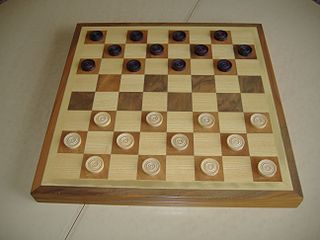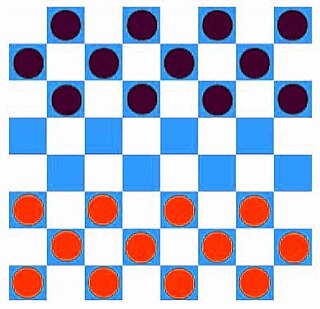Related Research Articles

Checkers, also known as draughts, is a group of strategy board games for two players which involve diagonal moves of uniform game pieces and mandatory captures by jumping over opponent pieces. Checkers is developed from alquerque. The term "checkers" derives from the checkered board which the game is played on, whereas "draughts" derives from the verb "to draw" or "to move".

International draughts is a strategy board game for two players, one of the variants of draughts. The gameboard comprises 10×10 squares in alternating dark and light colours, of which only the 50 dark squares are used. Each player has 20 pieces, light for one player and dark for the other, at opposite sides of the board. In conventional diagrams, the board is displayed with the light pieces at the bottom; in this orientation, the lower-left corner square must be dark.

Franeker is one of the eleven historical cities of Friesland and capital of the municipality of Waadhoeke. It is located north of the Van Harinxmakanaal and about 20 km west of Leeuwarden. As of 1 January 2014, it had 12,781 inhabitants. The Eise Eisinga Planetarium, established in 1781, is located in the city.

English draughts or checkers, also called straight checkers or simply draughts, is a form of the strategy board game checkers. It is played on an 8×8 checkerboard with 12 pieces per side. The pieces move and capture diagonally forward, until they reach the opposite end of the board, when they are crowned and can thereafter move and capture both backward and forward.

Turkish draughts (Armenian: շաշկի)(Arabic: دامە)(Kurmanji: دامە) is a variant of draughts (checkers) played in Turkey, Greece, Egypt, Kuwait, Lebanon, Syria, Jordan and several other locations around the Mediterranean Sea and Middle East.

Russian draughts is a variant of draughts (checkers) played in Russia and some parts of the former USSR, as well as parts of Eastern Europe and Israel.
Permainan-Tabal is a two-player abstract strategy board game from Indonesia. The game is sometimes referred to as a cross between Alquerque and Draughts. It is essentially Draughts played on an expanded Alquerque board. It is especially similar to Draughts in that the moves of the pieces are strictly forward and sideways until they are promoted to Kings by reaching the other player's first rank. The game is also referred to as Dama.
Zamma is a two-player abstract strategy game from Africa. It is especially played in mauritania. The game is similar to alquerque and draughts. Board sizes vary, but they are square boards, such as 5x5 or 9x9 square grids with left and right diagonal lines running through several intersection points of the board. One could think of the 5x5 board as a standard alquerque board, but with additional diagonal lines, and the 9x9 board as four standard alquerque boards combined, but no additional diagonal lines are added. The initial setup is also similar to alquerque, where every space on the board is filled with each player's pieces except for the middle point of the board. Furthermore, each player's pieces are also set up on their respective half of the board. The game specifically resembles draughts in that pieces must move in the forward directions until they are crowned "Mullah" which is the equivalent of the king in draughts. The Edhayam can move in any direction. In Mauritania, the black pieces are referred to as men, and the white pieces as women. In the Sahara, short sticks represent the men, and camel dung represent the women.
Dablo is a family of two-player strategy board games of the Sámi people. Different variants of the game have been played in different parts of Sápmi.

Armenian draughts, or Tama, is a variant of draughts played in Armenia. The rules are similar to Dama. Armenian draughts, however, allows for diagonal movement.
Czech draughts is a board game played in the territory formerly occupied by Czechoslovakia. It is governed by the Czech Draughts Federation.

Italian draughts is a variant of the draughts family played mainly in Italy and Northern Africa. It is a two-handed game played on a board consisting of sixty-four squares, thirty-two white and thirty-two black. There are twenty-four pieces: twelve white and twelve black. The board is placed so that the rightmost square on both sides of the board is black.

Dameo is an abstract strategy board game for two players invented by Christian Freeling in 2000. It is a variant of the game draughts and is played on an 8×8 checkered gameboard.

Congo is a chess variant invented by Demian Freeling in 1982 when he was nearly 8 years old. His father encouraged him to design a variant using a 7×7 gameboard. Demian was already familiar with chess and xiangqi, and the result blends some features from both. Congo became the second-most popular chess variant at the Fanaat games club in Enschede, the Netherlands.

Brazilian draughts is a variant of the strategy board game draughts. Brazilian Checkers follows the same rules and conventions as International draughts, the only differences are the smaller gameboard, and fewer checkers per player.

Poddavki, also known as Giveaway checkers, Suicide checkers, Anti-checkers or Losing draughts is a draughts (checkers) game based on the rules of Russian draughts, with the variation that a player wins if they have no legal moves on their turn, either by giving up all their pieces or having them all blocked. As in most varieties of draughts, capturing is mandatory. The game is played in Russia and some parts of the former Soviet Union.

Bashni, also known as column draughts, multi-level checkers, and rarer Chinese checkers, is a variation of draughts, known in Russia since the 19th century. The game is played according to the basic rules of Russian draughts, with the main difference being that draughts being jumped over are not removed from the playing field but are instead placed under the jumping piece . The resulting towers move across the board as one piece, obeying the status of the upper draught. When a tower is jumped over, only the upper draught is removed from it. If, as a result of the combat, the top draught changes colour, ownership of the tower passes on to the opposing player. Based on Bashni, but according to the basic rules of English draughts, world chess champion Emanuel Lasker developed the draughts game "Laska" and, in 1911, published its description. Lasker described towers that can only be "double-layered": i.e. there can be no alternation of colors. He also showed that during the game the number of game pieces either remains constant or decreases. Column draughts are a subject of interest for the mathematical Sciences: combinatorics, theory of paired zero-sum games, etc.

Tanzanian draughts is a unique variant of draughts (checkers) board game originally played in modern day Tanzania. This is the strategy game that is played by two people using pieces on board. The game is very similar to Czech draughts but in this type the player can capture using king or men, there is no priority for that. Apart from that they are completely similar in any way. The game is also somehow similar to American checkers and Shashki in case of starting position. The game can be regarded as American checkers with the addition of a "flying king", which captures as in Russian draughts.

Malaysian checkers or Singaporean checkers, is a variant of the board game of draughts played primarily in Malaysia and Singapore, especially among the elder men. Similar to the Canadian checkers, it is played on a 12x12 checkered board. The game can also be played on a 8x8 board if a 12x12 board is unavailable. However, it is distinct from Checkers and Canadian Checkers in terms of its additional rules. Popular alternative names used locally for this game include Dum and Dam.
Keny is a draughts game played in the Caucasus and nearby areas of Turkey. Keny is actually the Ossetian name for the game as it is most popular in Ossetia, a region in the Caucasus. In Armenia, it is called Vayut tama. The game is also known as Caucasian checkers. There may be slight variations of the game, but the rules described here are from Nikita Sokolov from his article "It's been a while since we took checkers into our hands..." (2005).
References
- ↑ Kok, Fred. "A Beautiful Move in Frisian Checkers." The New Abstract Games Vol. 10, pp. 13-14.
- 1 2 World Frisian Draughts Foundation. Official Rules for Frisian Draughts . 2011. Accessed 24 Aug. 2021.
- ↑ "Frisian Draughts". mindsports.nl. Archived from the original on 2021-08-25. Retrieved 2021-08-24.
- ↑ "Internationale top op WK Fries dammen in Franeker". Franeker Courant (in Dutch). 2020-03-01. Archived from the original on 2021-08-25. Retrieved 2021-08-25.
- ↑ "Marten Walinga opnieuw wereldkampioen Fries dammen". Omrop Fryslân (in Dutch). 2021-08-19. Archived from the original on 2021-08-25. Retrieved 2021-08-24.
- ↑ "Elf dagen lang concentreren, Marten Walinga uit Waaksens en Folkert Groenveld uit Jutrijp strijden in Harlingen om wereldtitel Fries dammen". Friesch Dagblad (in Dutch). Archived from the original on 2021-08-25. Retrieved 2021-08-25.
- ↑ "Wereldkampioen Fries dammen: "De volgende komt uit Rusland of China"". Omrop Fryslân (in Dutch). 2021-08-23. Archived from the original on 2021-08-25. Retrieved 2021-08-25.
- ↑ "Folkert Groenveld kampioen Fryslân Open 2020 | Franeker Courant". archive.is. 2021-08-25. Archived from the original on 2021-08-25. Retrieved 2021-08-25.
{{cite web}}: CS1 maint: bot: original URL status unknown (link)